2nd Grade Word Problems
Lessons on solving word problems using tape diagrams, block diagrams or bar models, for students in Grades 2.
Related Pages
Grade 2 Math Lessons
Singapore Math Lessons
Arithmetic Worksheets
Arithmetic Lessons
The following are some examples of 2nd Grade Word Problems for addition, subtraction, multiplication and division. These word problems are solved with the help of "thinking blocks" or "block diagrams" which are used in Singapore Math or tape diagrams used in Common Core Math.
The following diagrams show how Part-Part-Whole Model, Comparison Model, Equal Parts of a Whole Model. Scroll down for examples and solutions.
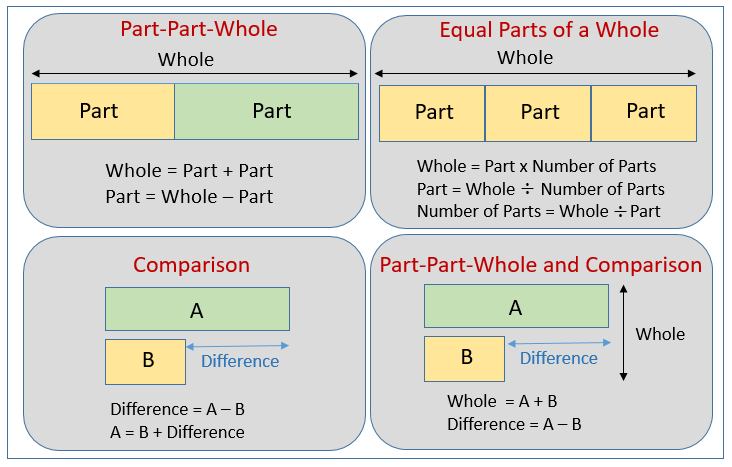
Addition
Example:
There are 56 passengers in Bus A and 39 passengers in Bus B. How many passengers are there altogether
in the two buses?
Solution:
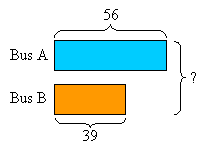
So, 56 + 39 = 95
There are 95 passengers altogether in the two buses.
Subtraction
Example:
A fruit seller had 84 lemons. He sold 56 lemons. How many lemons did he have left?
Solution:
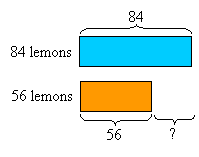
So, 84 – 56 = 28
He had 28 lemons left.
Multiplication
Example:
There are 2 papayas in each box. How many are there in 4 boxes?
Solution:
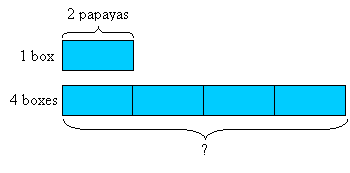
4 × 2 = 8
There are 8 papayas in 4 boxes.
Division
Example:
Alex bought a sack of 27 kg of flour. He packed the flour equally into 3 bags. How many kilograms of flour
were there in each bag?
Solution:
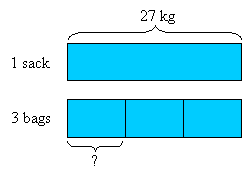
27 ÷ 3 = 9
There were 9 kg of flour in each bag.
Helping Parents Explain Math - Grade 2 Word Problems
How to use “thinking blocks” to help even young children - 1st grade, 2nd grade - understand, model and solve word problems.
Example:
- David has 45 marbles. His sister gave him 32 more. How many marbles does he have altogether?
- Caleb wants to buy a scooter that costs $63. He saved $38 so far. How much more money does Caleb need?
Helping Parents Explain Math - Word Problems 2
How to use “thinking blocks” to help even young children - 1st grade, 2nd grade - understand, model and solve word problems.
Example:
- Anna is riding in a bike-a-thon. She rode 48 miles in the morning, stopped for a lunch break, then rode another 37 miles in the afternoon. Anna was then only 62 miles from the finishing line. How long was Anna’s bike ride?
- Kierka bought a juice for 55 cents, a breakfast bar for 27 cents and a package of gum. She spent $1/22 altogether. How much did the package of gum cost?
Adding with Thinking Blocks or Block Diagrams
Example:
Alicia has $6 more than Bobby. If Bobby has $10, how much do they have altogether?
Subtracting with Thinking Blocks or Block Diagrams
Example:
Mr. Oliver bought 88 pencils. he sold 26 of them. How many pencils did he have left?
Multiplying with Thinking Blocks or Block Diagrams
Example:
- Ben the Baker puts three brownies into each gift box. How many brownies should Ben the Baker bake in order to fill ten gift boxes?
- Blake donated his collection of adventure books to a local school. He packed ten books in each of his three boxes. How many books did Blake donate?
Model Drawing for Second Grade
- Step-by-step visual method of turning a word problem into a diagram with unit bars which represent values.
- Can make a complicated problem seem easy.
- Provides a bridge from the pictorial to abstract. It is a tool.
- 80% of word problems can be solved with model drawing (50% in middle and high school).
- Students start to become less intimidated by math and start enjoying it.
How to solve Addition Problems using Part-whole Models?
- Sean has 2 plastic cars. He also has 5 wooden cars. How many cars does Sean have altogether?
- Amy has 3 green marbles. She also has 6 blue marbles. How many many marbles does Amy have altogether?
How to solve Addition Problems using Comparison Models?
- Jesse had $3.00 more than Clinton. If Clinton had $10.00, how much money did they have altogether?
- Penny ate 6 ice cream cones more than Jeff did over the weekend. If Jeff ate 8 ice cream cones, how many ice cream cones did they eat altogether?
How to solve subtraction problems using Part-whole Models?
- Nathan had $27 to buy gifts for his family. If he spent $9.00 on a gift for his brother, how much money did he have left to spend on the rest of the family?
- Mike has 21 crayons. Elisha has 6 crayons. how many more crayons does Mike have?
- Tom has 97 pennies. Samantha has 29 pennies. How many more pennies does Tom have?
Mixed Operation Bar Model Problem
- Josh scored 27 points in the championship basketball game. That was 12 points more than his friend Luke scored. How many points did they score altogether?
Try the free Mathway calculator and
problem solver below to practice various math topics. Try the given examples, or type in your own
problem and check your answer with the step-by-step explanations.

We welcome your feedback, comments and questions about this site or page. Please submit your feedback or enquiries via our Feedback page.